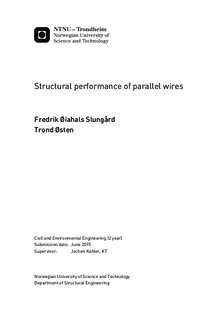| dc.contributor.advisor | Kohler, Jochen | |
| dc.contributor.author | Østen, Trond | |
| dc.contributor.author | Slungård, Fredrik Øiahals | |
| dc.date.accessioned | 2015-10-30T15:00:27Z | |
| dc.date.available | 2015-10-30T15:00:27Z | |
| dc.date.created | 2015-06-10 | |
| dc.date.issued | 2015 | |
| dc.identifier | ntnudaim:12171 | |
| dc.identifier.uri | http://hdl.handle.net/11250/2358833 | |
| dc.description.abstract | Many of the cable bridges in Norway, and Europe are in general nearing their estimated lifespan. Due to the sheer number of bridges, it is not possible to rebuild or redesign all of these. However, many are still in good condition, a scheme to verify their reliability are required. The cables make up the load bearing part in a cable bridge, failure of these cables leads to the failure of the entire bridge. One of the main concerns, especially regarding older bridges, is that the cables are subject to corrosion damage and the uncertainties related to the remaining reliability.
The main goal of this thesis is to create a framework in MATLAB that displays the system effects that influence the capacity of the cable and an updating scheme for the strength- and reliability distribution of the cable. The first part of the thesis focus on the properties of steel cables and system effects that influence the cable capacity. Daniels effect and length effect are commonly considered as system effects. Daniels effect take into account that the strength of a cable consisting of 150 wires and more tends towards a normal distributed of the cable strength. This leads to a capacity reduction between 6-8 %. Length effect takes into account that the number of links in a wire increase over time, which lead to a reduction factor around 8-10 % of the capacity. The effect of initial wire strain is shown to have an impact on the cable capacity and should therefore be taken as a reduction factor along the same lines as Daniels- and length effect.
The second part of the thesis focus on the updating of the strength and reliability distribution of the cable. An updated strength distribution of the cable is found with the use of Bayesian statistics. Baye s method updates the strength distribution when additional information are implemented. This new information are gathered through use of proof or failure testing of the wires. The probability of failure are based on the updated strength distribution, which again are used to calculate the reliability of the cable. | |
| dc.language | eng | |
| dc.publisher | NTNU | |
| dc.subject | Bygg- og miljøteknikk (2-årig), Konstruksjon | |
| dc.subject | Bygg- og miljøteknikk (2-årig), Prosjektering av konstruksjoner | |
| dc.title | Structural performance of parallel wires | |
| dc.type | Master thesis | |
| dc.source.pagenumber | 137 | |

